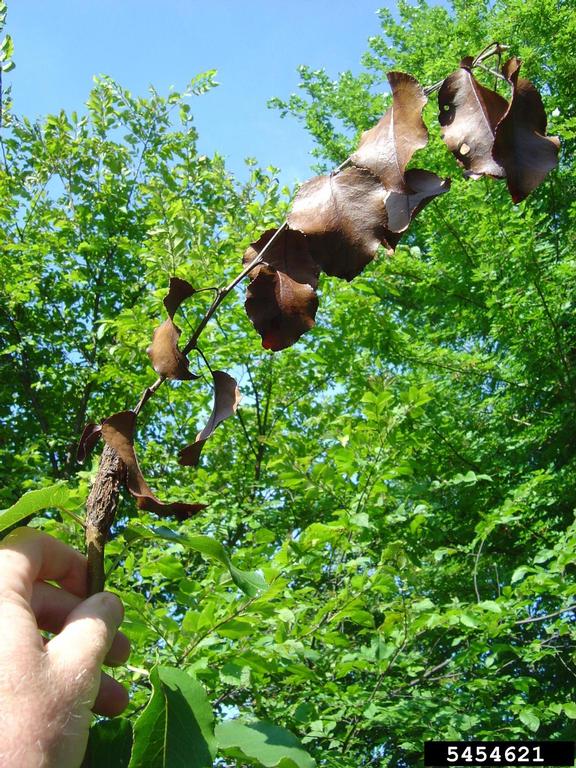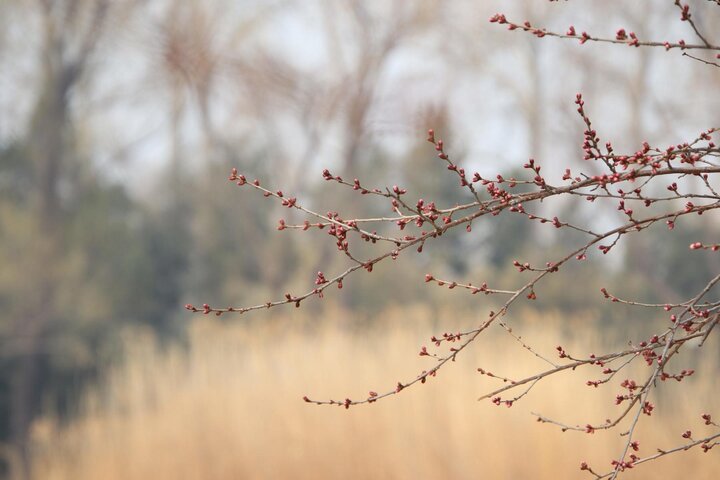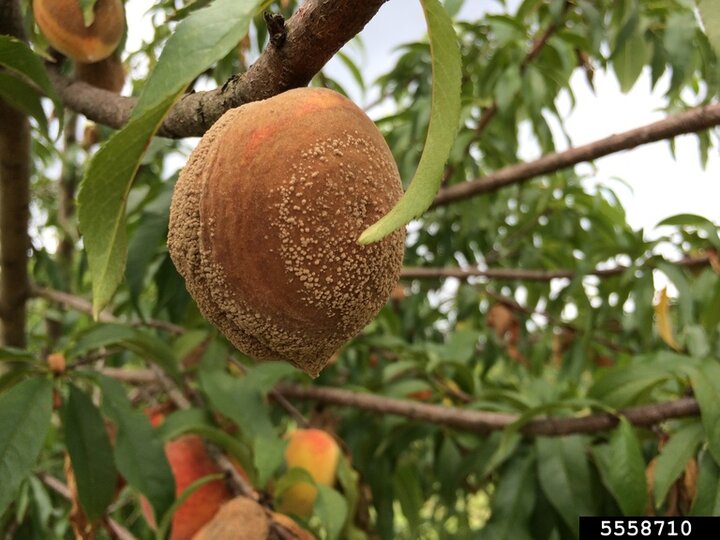Sarah Browning, Nebraska Extension Educator

Fireblight on a pear stem. Image by Jason Sharman, Vitalitree.
Last week we looked at winter drought and watering. But many gardeners also have questions about spring pruning. Specifically, is the time to prune affected by warm winter conditions? Here are a few pruning -related questions I have received lately.
- Will early pruning cause fruit tree leaf and flower buds to develop earlier and possibly be damaged by normal spring frosts?
- Should pruning still be done in March and early April or should it be done earlier since conditions have been so warm?
- Does pruning too late – after warmth has caused buds to swell or flowers to bloom – have detrimental effects on fruit production in the home orchard?
- What about shade trees? Should any adjustments in the time of pruning be made in response to recent warm conditions?
Let’s discuss each question, but first it’s important to understand woody plant leaf and flower buds were formed last fall. They are already present on branch twigs, so you should be able to find dormant buds when doing a close examination of your plant now. The presence of buds now is normal and does not mean plants are actively growing yet.
Does pruning cause early leaf and flower bud development?
No, pruning actually has a slight delaying effect on bud growth. After pruning, a plant has to adjust and begin sending growth hormones to new buds, since the preferred buds at the tips of branches removed are now gone. This process could take about 10 days, so bud development is slowed down a little. But it’s risky for growers to use pruning to slow down and "protect" flower buds.
Best time to prune
Less winter hardy tree fruits like peach, apricot and sweet cherry should always be pruned in late winter, usually mid-March to early April, no matter how much warm mid-winter weather we experience. Pruning is done just before new growth starts. This is also the best practice for the more cold-hardy fruits, like pear, apple, plum tart cherry and shade trees.
Why? Pruning at this time has two big benefits. First, there is less chance of cold damage at the pruning sites. Second, plants heal pruning wounds much faster if the cuts are made just before new growth begins.
There still plenty of time for cold late winter temperatures and freezes, which will slow bud development down. And early pruning leaves plant susceptible to cold temperature injury at the pruning sites.

Does late pruning, after blooming or growth has begun, have a detrimental effect on fruit trees?
Pruning can be done after growth begins, but it becomes very important to prevent the spread of common diseases, like fireblight and brown rot, with each cut of your pruners. That’s one of the main reasons dormant pruning is preferred.
Pruning after blooming begins does not reduce fruit production more than normal dormant pruning. Some flower buds are removed, but fruit trees do require annual thinning of fruits. In particular, peaches normally set many more fruits than the tree can support physically or develop to a good size. Breaking of peach tree branches under excess fruit weight is a common occurrence. Only 10% of peach flowers are needed for full crop set.
Fireblight is a serious disease of apple, cherry, crabapple, pear and plum. Watch for brown dying flowers and twigs dying back quickly with brown or black leaves. Prune out and discard all infected twigs and branches with cankers. Cuts should be at least one foot below the infected area. Pruning tools should be disinfected after each cut by dipping the cutting surface into a disinfectant such as 70 percent alcohol or a diluted household bleach solution (one cup household bleach to nine cups water).

Brown rot is a common disease of peach and apricot which results in stem cankers. Watch for signs of cankers during pruning. Cutting into an active canker could result in spreading the disease to new stems. Remove cankered stems by cutting back several inches into healthy tissue. As with fireblight, cleaning pruners between each cut is the most aggressive way to prevent spreading the disease throughout trees.
What about shade trees?
For homeowners who can choose the ideal time to prune, shade trees should also be pruned just before growth begins in spring. If you need to hire an arborist to prune a large tree, then anytime between now and early May would be a great time to prune.
More information: Pruning Fruit Trees
Images:
- Fireblight on a pear stem. Jason Sharman, Vitalitree.
- Peach flower buds. Image from Pixabay.com. Caption - Ideally, peach trees should be pruned before flower buds begin to open. Hopefully recent cold temperatures will prevent early development. This is not a Nebraska peach tree!
- Fruit rot stage of brown rot on peach - Rebecca A. Melanson, Mississippi State University Extension.
Search Our Archive
Associated Video
Fire Blight
Nebraska Extension Plant Diagnostician Kevin Korus shows some examples of fire blight on crabapple trees and gives some tips on how to control it.